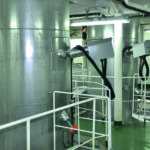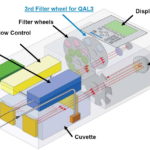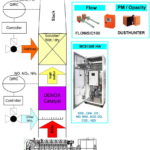Gas analyzers measure exhaust gases not only to meet ECA limits, but also to prevent methane slip using LNG as fuel. By Jens Béchu and Markus Haas from Sick
In the 1950s belching smokestacks were the sign of growing industry, especially in the larger industrial areas with heavy steel[ds_preview] production, but this quickly became an environmental problem. Germany established the first legislation against air pollution in 1964 with the »TA Luft« (Technische Anleitung zur Reinhaltung der Luft) regulation. In 1974, the »Bundes-Imissionsschutzgesetz« (BISchG) replaced this regulation for specific industries. From the beginning, the laws established an environmental impact (exposure), defined as »air pollution, noise, vibrations and similar activities«, to be regulated. Due to the fundamental concentrations of the imponderable impact, more air-related laws were introduced as a result of integrated approaches to environmental protection within the European Union.
The important European directives for stationary source emissions are:
• 2000/76/EC: Waste incineration plants,
• 2001/80/EC: Large combustion plants,
• 99/13/EC: VOC directive,
• 96/61/EC: Integrated Pollution Prevention and Control (IPPC) directive.
These are now combined in the new EU 2010/75/EC Industrial Emission Directive: In turn, these regulations refer to the following standards:
• EN 15267: Certification of automated measuring systems,
• EN 14181: Quality assurance of automated measuring systems.
In 1970, the Clean Air Act (CAA, founded in the U.S. Code, Title 42, § 7401 ed sqq) adopted the first federal anti-pollution laws in the US. There, the CAA is implemented and monitored by the Environmental Protection Agency (EPA), an organization working on environmental matters and regulations. The regulations concerning emission monitoring (continuous analyzers and reference methods) are described in:
• 40 CFR (Code of Federal Regulations) part 60 (standards of performance for new sources),
• 40 CFR part 75 (established requirements for monitoring, record keeping and reporting of SO2, NOx and CO2, volume flow, opacity).
Over the last four decades, nearly all countries around the world have implemented regulations to control and monitor air pollution for stationary sources. When a country fails to create its own regulation, it follows those used in Europe or the US. The IMO´s Regulations on Prevention of Air Pollution from Ships, MARPOL Annex VI, is the first regulation for maritime emission sources for ships, drilling rigs and platforms. In the Technical Code 2008 for NOx emissions and the Resolution MEPC.184 (59) entitled Guidelines for Exhaust Gas Cleaning Systems for SO2 emissions specify the regulations in more detail.
In Chapter 2 of the NOx Technical Code and Appendix III measuring methods, analyzer calibration, accuracy requirements, drift and noise is described. Appendix IV describes precisely how to calibrate, how often and which purity grade gases to use. Appendix VIII describes the implementation of direct measuring and monitoring methods of the exhaust gas analyzer monitoring system.
Compared to the EPA-controlled CFR regulation, the Industrial Emission Directive 2010/75/EC for onshore stationary sources is controlled by independent and certified organizations like TÜV. The analyzer equipment used on ships must be certified in addition from a classification society.
Analyzer for continuous control
The MCS100E HW analyzer continuously measures the amount of SO2, CO2 and NOx for extended periods and with high precision. From sampling to the cuvette, all paths in contact with the measuring gas are heated over the dew point and thus protected against corrosion. Further, the MCS100E HW is provided with an automatic calibration check filter. This saves time and expensive calibration gases. The data transfer via bus connection to the vessel’s process control works quickly. From one customer we at Sick are asked to check the measured results and the functionality of the analyzer on a daily base by direct remote control to the ship. The MCS100E HW usually measures one single gas flow, it can, however, switch between different exhaust channels. This can be done either automatically or manually.
Apart from the compulsory components, the system is able to measure up to eight additional components. If natural gas low in sulfur is used as a fuel, the analyzing system can even reliably measure the methane slip, which escapes the incineration. Methane is one of the most climate-relevant greenhouse gases. If the exhaust is catalytically cleaned from nitrogen oxides in the future, the analyzing system could take over control here too. The injection quantity of ammonia or urea can be regulated by the measurement of NH3.
Low maintenance, high accuracy
According to the NOx Technical Code 2008, Appendix III, Pt. 1.3, the measuring range of the analyzer should be adjusted to the measured value. The measured concentration should be between 15 % and 100 % of the full scale, where the full scale refers to the measurement range used. For example, if one wants to measure a value of 50 ppm SO2, the measurement range should be no larger than 333 ppm. MCS100E analyzer has a smallest measuring range for SO2: 30 ppm (4.5 ppm is the lowest allowed measurable value). This high sensitivity finds its direct correlation in very low drift span and zero values. For both values, the IMO regulation request in NOx Technical Code 2008, Appendix 3, Pt. 1.9 and 1.10, stipulates less than 2 % of the full scale within a one-hour period. The analyzer has origins in onshore industries, where the requirements are much stricter than those for maritime. For example, the drift should not exceed 2 % within the regular maintenance interval.
The maintenance interval is roughly every six months, which is certified by TÜV. Therefore, it fulfills the same drift of 2 % over a period of six month instead of one hour. The advantage during the daily use for the maritime industry is that there is no need to calibrate more often than requested by the IMO regulation. Every three months is sufficient. This saves workload and span gases. Since span gases are very important in proving that the analyzer is correctly measuring, it is essential that they do not run out. The analyzer is equipped with a tool (Fig. 2) for checking the correct calibration without span gases. This is in accordance to NOx Technical Code 2008 Pt. 5.5.1.4. For onshore industries, the analyzer fulfills the so-called QAL 3 regulation, which is part of the EN 14181 (quality assurance of automated measuring systems). This tool is certified by an independent inspection and TÜV. The QAL 3 certification saves span gases onboard ships. Since span gas has a production time of four to six weeks and compressed gases are forbidden from being transported via air, delivery requires sufficient time to the ship. Therefore, due to time constraints, it is essential not use more gas then necessary.
Certified for all applications
The MCS100E HW analyzer is certified by Germanischer Lloyd (12764-10 HH) and can be used for all applications stated in the NOx Technical Code Pt. 2.1.2:
• test bed testing and precertification of engines,
• onboard testing for engines, which have no precertification,
• onboard simplified measurements, but with a fixed installation, allowing sample switching between several sample points with a single analyzer,
• onboard direct measurement and monitoring.
It is also certified for exhaust gas cleaning systems according to MEPC 184 (59):
• Scheme A, survey and certification, using parameter and emission checks,
• Scheme B, continuous monitoring.
The MCS100E HW measures also components which are not required by the IMO. Here, the possibility of measuring methane is an example. Sick can measure methane slip of dual fuel engines within the same analyzer. Another example is the measurement of ammonia slip after an SCR catalyst – for control of the urea injection. Excessive urea injection causes corrosion in extreme as well as harm to our environment. For boiler combustion it is possible to measure carbon monoxide to optimize the combustion process.
References and experiences
The MCS100E has been used in more than 1,500 installations in power plants, waste incinerators and in the cement industry. This valued analyzer is now tested and certified for use on board ships and got positive responses from customers like Norwegian Cruise Lines, Wärtsilä, MAN and Shell. In addition to gas analyzers, Sick also has experience with onboard dust analyzers, flow measurement of stack gases and high accuracy flow measuring of natural gas. It provides breathable gas analyzers for submarines.
Sick – having almost 6,000 employees in more than 80 countries – delivers the equipment for measuring tasks, provides structured documentation and high quality training. Service staff offers support during installation, commissioning and maintenance.
Authors:
Jens Béchu,
Strategic Industry Manager Combustion Engines
Markus Haas
Technical Industry Manager Combustion Engines Both at Sick Maihak GmbH
maritime@sick.com
Jens Béchu, Markus Haas





















